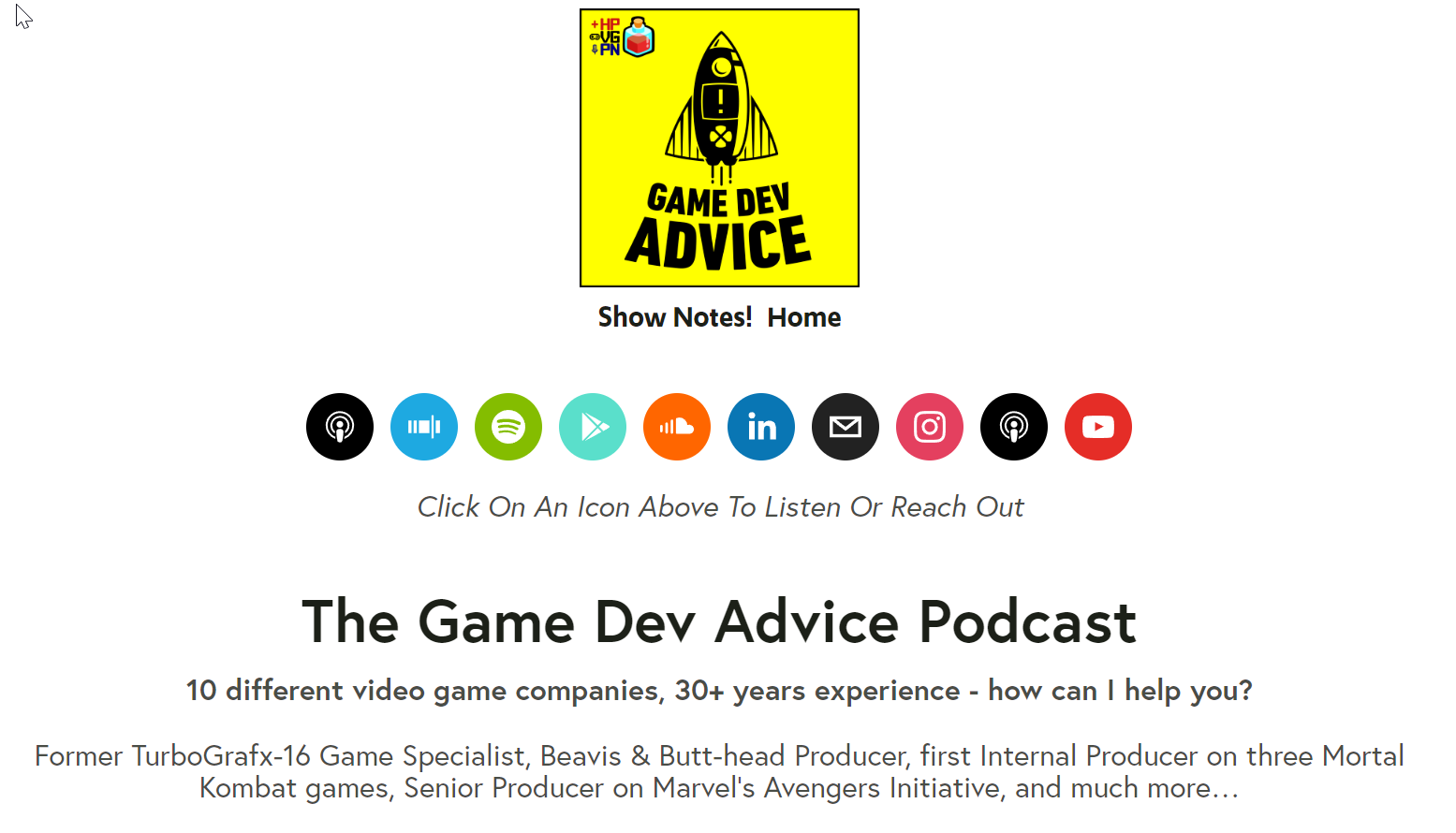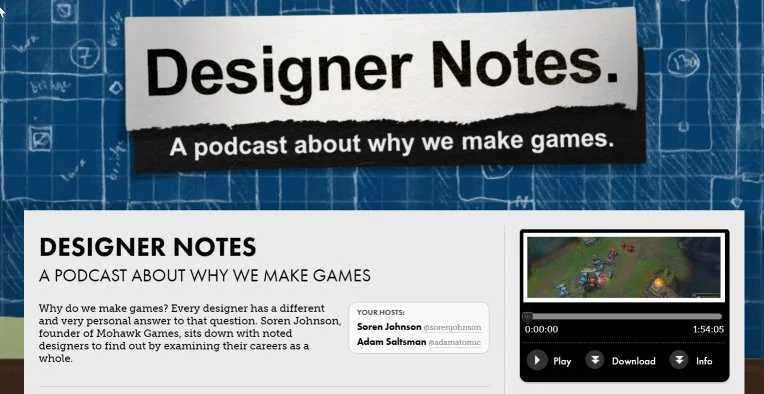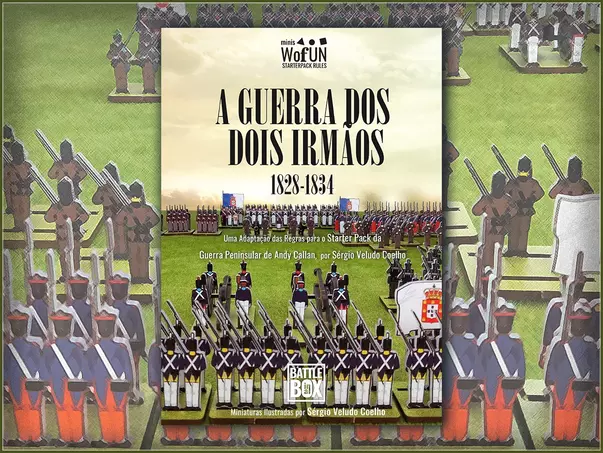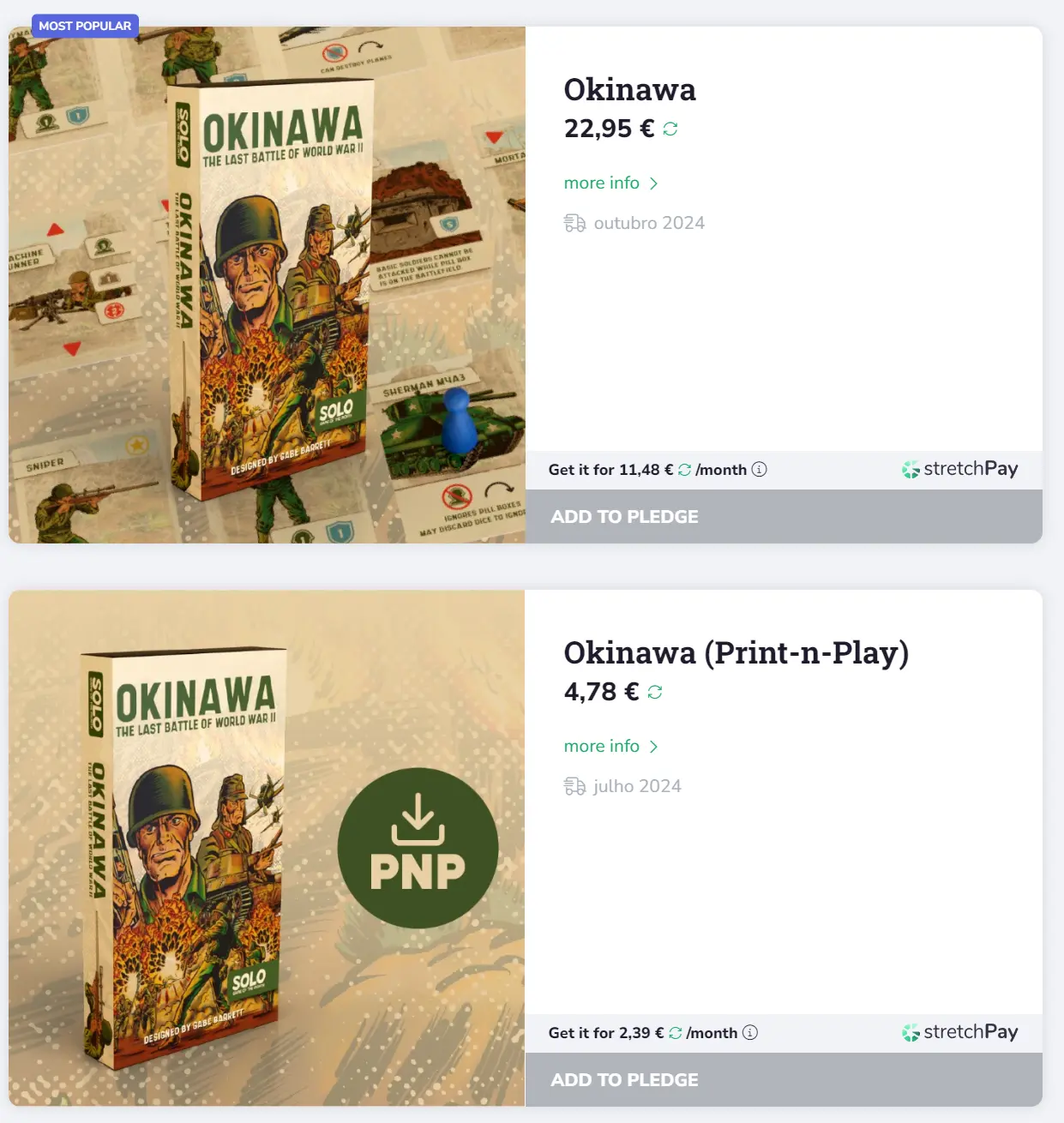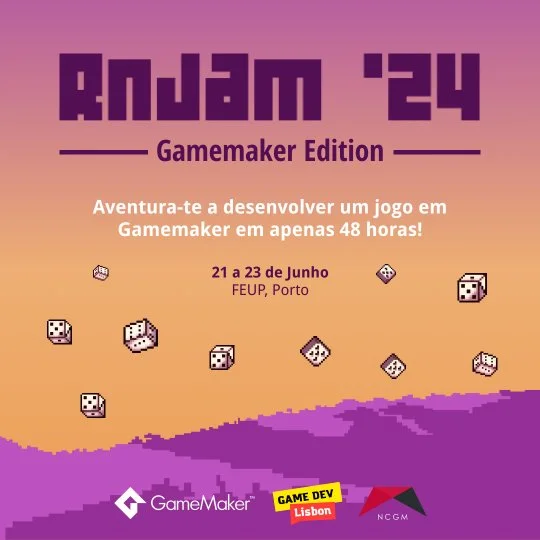Month: June 2024
Uma entrevista a Mike Lambo
Um dos designer de jogos de tabuleiro que tenho seguido é o Mike Lambo, tem feitos jogos para um único jogador em formato de livro. A entrevista feita por Grant em maio de 2024 sobre o livro “Lone Sherman: The Pacific” e surge o seguinte (para aquivo):
“Over the past several years, the solitaire tactical book wargame has gained a lot of traction in our hobby. A solitaire wargame that is fairly affordable at $20-$30 and can be purchased from on-line retailers like Amazon. What is not to like? And the name of Mike Lambo has been tied to a lot these games as he has designed 20+ of these titles and has built quite the rabid and loyal fanbase. Well, a few months ago, I decided that I was going to give his system a try and I purchased his newest game called Lone Sherman: The Pacific. I just had to find out what all the fuss was about. Now, I have looked into the book, and actually made some copies of the counters, but have yet to get up the gumption to do arts and crafts time to build the units so I can play. But, I am going to play it this year and share my thoughts on our channel. I also reached out to Mike to offer to do one of our designer interviews and he was more than willing to share.
Grant: First off Mike please tell us a little about yourself. What are your hobbies? What’s your day job?
Mike: Well I’m retired now but I was a university lecturer here in the UK for many years. I now enjoy travelling, walking and generally taking it easy. And designing wargames of course!
Grant: What motivated you to break into game design? What have you enjoyed most about the experience thus far?
Mike: To be honest, I’ve always enjoyed designing games, initially as a child and then for my own children when they were younger. It was only the ability to publish my own games in book format that enabled me to share some of my ideas with others. I will always enjoy the design process itself of course, but I cannot deny that I get a kick out of knowing that others enjoy my games too. I’m amazed how popular they have become.
Grant: Why has your Lone Series of games been so successful? What about the games has appealed to solo wargamers?
Mike: I’m not sure. I think games that allow players to use their imagination and create stories have always been popular, especially amongst wargamers. Lone Sherman allows an element of that but also retains the need for tactics and decision making, as well as being easy and relatively quick to play.
Grant: What is your upcoming game Lone Sherman: The Pacific about?
Mike: The game is a sequel to Lone Sherman and once again puts the player in control of a sole Sherman tank, this time taking place on several Pacific Islands in World War II. The game is about controlling that tank in order to survive and to complete scenario objectives whilst helping to protect your fellow American forces.
Grant: Why was this a subject that drew your interest?
Mike: I’ve always been interested in World War II, and whilst it has tended to be the European aspect of the war that has interested me the most in the past, I have recently become more intrigued by the Pacific Island invasions and the tactics used by both sides in those battles.
Grant: What is your design goal with the game?
Mike: The game follows my general design goals which are always to make a very playable game which is quick to set up and play but leaves the player feeling as though they have had a tough and engaging challenge which required them to make tactical decisions and other choices along the way.
Grant: What other designs inspired you in making this game?
Mike: I love D-Day at Tarawa form Decision Games which is the first Pacific based solitaire game I ever bought. I guess I was loosely influenced by other tank games such as Patton’s Best as well but Lone Sherman is very different from that game. The design itself is mostly based on a game I designed many years ago for my own use!
Grant: What elements from the Pacific Theater of Operations from WWII do you need to model in the design?
Mike: The key thing for me was to make this game different enough from Lone Sherman (which is based in Europe) and so I focused on the terrain and the Japanese forces and tactics. Whilst players of the original Lone Sherman will easily recognize the mechanics in this game, the feel is quite different as they battle against weaker Japanese tanks and more mobile and potentially lethal infantry charges.
Grant: As a solitaire game how does the AI function?
Mike: Generally, the player rolls a number of dice depending on the AI unit which is activating and then consults some (brief) charts to determine what that unit will do. Artillery units are fairly static and will try to fire at the Sherman where possible. Japanese tank units will often try to flank the Sherman and fire at it where possible. Infantry units will charge directly toward the Sherman with the intention of destroying it with mines and other anti-tank weapons.
Grant: What goals drive the AI?
Mike: That’s simple – to stop the player from achieving their objectives, preferably by destroying the Sherman! There main focus is that and the Japanese fanaticism really drives that part of the game. From banzai charges to other suicidal tactics.
Grant: What type of experience does it create?
Mike: I like to think it creates a pretty realistic experience in terms of not always having clear line of sight, not always being able to do exactly what you want to do, and facing the possibility of being hit at any time. Movement can also be frustrating, especially when trying to land on the beach from shallow water. Whilst straightforward, it tries to create a feeling of being confined in a tank which feels quite safe in some respects, being well-armed and well-armored, and yet very precarious in other respects.
Grant: How does the player have some degree of control over the level of risk they wish to take?
Mike: The player rolls dice to establish what actions they have available to them for the game turn. The number of dice depends on the terrain the tank is on and the crew members which are still alive. The player can mitigate risk by positioning the tank on ‘safer’ terrain, keeping the commander inside the tank, not moving too close to enemy lines of sight, trying to flank the enemy and taking note of the type of events that can occur at the end of each turn. In fact, there is an awful lot to think about, and it is easy to leave your tank more vulnerable than it needs to be, but practice makes perfect I guess!
Grant: How do Events come into the game? What do these Events represent?
Mike: Events occur at the end of a turn and are randomly generated by a die roll on a chart. They represent things over which the tank crew cannot have full control, although the player can mitigate this risk to a degree. Some of these Events only occur under certain circumstances, and the player can choose to ensure that these circumstances are not satisfied if they want to be more cautious.
Grant: Can you share with us some examples of these Events? Also how the effects can be mitigated?
Mike: Examples include enemy sniper and mortar fire, mechanical failure, enemy reinforcements and mines. In terms of mitigation, an example would be that the Commander cannot be hit by sniper fire if he is safely inside the tank.
Grant: How does the game include a mechanism to reflect US casualties in the theater?
Mike: Many of my games have turn counters to act as a timer. Lone Sherman did not have that, and neither does this sequel. However, the game does reflect the fact that there were obviously thousands of other US forces on the island which were the subject of horrific enemy fire. Each turn, the player rolls dice to determine the rate at which general US casualties increase. They are likely to increase more quickly if there are more enemy units on the map at the time. This gives the player an incentive to keep attacking, even when they may prefer to sit back and hide, because if those casualties get too high, the game ends in defeat.
Grant: How does the player prepare the book game for play?
Mike: The book includes a counter sheet as its final page which can be removed or downloaded from the files section of BoardGameGeek.com. It is relatively easy to stick this to medium card and cut out the counters. They can then be used directly on the maps included in the book, or again the maps can be downloaded from BoardGameGeek.com. Personally, I print the counters onto an A4 printer label, stick it to card and cut them up with scissors. I then open the book, pressing the spine down firmly to flatten it, and then use the counters on the maps in the book.
Grant: Where can they get advice on how best to do this?
Mike: People can see me make counters and play all my games on my YouTube channel – Mike Lambo Solitaire Book Games.
Grant: What is the makeup of the Japanese enemy units? What different type of units are represented?
Mike: There are heavy artillery units which are static and represent large guns in huge concrete bunkers. Whilst they can take out the Sherman if it moves in front of them, they are mainly there to cause general US casualties. Anti-tank artillery units do move and will turn to face the Sherman so are more dangerous in that respect. Japanese Type 95 and Type 97 tanks move around the map and whilst they are fairly weak, they can certainly cause serious damage if underestimated, especially against the Sherman’s weaker side and rear armor. Finally, infantry units with anti-tank weapons will only attack the Sherman when up close but if that is allowed to happen they can pack a real punch.
Grant: What crew members are represented in the game? What different abilities do they have?
Mike: The usual five Sherman crew members are present here. The Commander is in charge and can pop open the hatch if the player decides that is a good idea. He gives movement and attacking bonuses and also bonuses as one of the end of turn events. The Gunner and Loader provide attacking bonuses, including firing and loading the main gun and firing the machine guns (crucial to keep the Japanese infantry at bay). The Driver and Assistant Driver provide movement bonuses and machine gun bonuses too. It is fair to say that losing any crew member is a significant disadvantage.
Grant: If a crew member is KIA how does the player makeup for their absence?
Mike: Fortunately, losing a crew member will not generally mean that the tank cannot move or fire – it can still undertake its basic operation – it will simply be less efficient in doing so. Losing a crew member will often mean that the player will need to take more risks with popping their Commander out of the hatch to help with movement and attacking, something they will often rather not be doing.
Grant: How does the player make an attack?
Mike: Attacks consist of firing the main gun or firing the machine guns. The main gun must be loaded each time it is fired. Attacks are carried out by rolling dice with the target number being determined by several factors including the target unit and terrain features. Attacks using the main gun must hit and then cause damage. For attacks made against the Sherman it is also necessary to determine what type of damage has occurred.
Grant: What different types of damage can be taken?
Mike: The main damage caused to the Sherman is that it will be set on fire. This results in a ‘fire test’ each turn which can cause more damage or the destruction of the Sherman (and defeat for the player). The more fire damage the Sherman has, the more likely it will be destroyed. Fortunately the fire level can be reduced by the crew using an extinguish action. The tank can also be immobilized and the turret can be damaged (both of which can be repaired). In addition, crew members can be killed in action.
Grant: What is the general Sequence of Play?
Mike: There are seven phases to each turn. The player gets to decide where the Commander is going to be for the turn, either out of the hatch or inside the tank. The Sherman then gets to operate and the crew get to perform various actions. The fire check takes place then before the Japanese units get to activate, and general US casualties are determined, with the events occurring at the end of the turn.
Grant: How many different scenarios are included?
Mike: There are 12 scenarios with individually designed maps, enemy force compositions and objectives for each one.
Grant: How do they create a campaign?
Mike: The 12 scenarios are split into four sets of three and each of the four sets can be played as a campaign, with the player taking their Sherman onto the next scenario as they successfully complete each one, generally retaining the situation the tank is in, with some minor recovery opportunity between scenarios.
Grant: How do players achieve victory?
Mike: By completing the scenario objectives (or all three scenario objectives if playing a campaign). These usually involve clearing a map of enemies, or of a certain type of enemy, or simply finding a clear passage through the mayhem.
Grant: What do you feel the design excels at?
Mike: That feeling of having control over a Sherman and making things work and feeling relatively safe, until it all goes horribly wrong!
Grant: What other designs are you currently working on?
Mike: I’m always working on several designs at any given time. A couple are in the early stages but I do have a relatively advanced Eastern Front ‘Battles’ game which I hope will be ready for publication later this Spring.
Thank you so much for your time in answering my questions Mike. We very much appreciate it. I have purchased this game and will get it to the table soon and look forward to sharing my thoughts.”
+infos(fonte): LINK
+infos(amazon livros): LINK
Probabilidades em jogos de tauleiro
Encontrei este post sobre probabilidades em jogos de tabuleiro. Interessante como uma introdução simples a este mecanismo.
”
Board games have always been a cherished pastime for friends and family. Whether you are navigating the dynamic world of Settlers of Catan, amassing property in Monopoly, or orchestrating epic battles in Risk, one common element consistently adds excitement and unpredictability to these games: dice. The roll of the dice often determines the outcome of the game, and having this understanding of probability can transform every move into a strategic calculation.
EXPLORING THE ROLE OF PROBABILITY IN BOARD GAMES A STRATEGIC PERSPECTIVE
Defining Probability
In the context of board games, this event is often the result of a dice roll. Dice typically has a specific number of sides, most commonly six. When you roll a standard six-sided die, each face has an equal chance of landing face up, which is 1/6.
In the world of board games, probability is a fundamental concept. It governs a significant portion of the game’s mechanics, with dice rolls determining everything from player movement to battle outcomes and resource acquisition. So, let’s see how these principles come to life in two iconic board games.
Methodology: Probability at Play
To better understand how probability works in these board games, let’s delve into the methodology of calculating probabilities and their application.
Calculating Probabilities in Monopoly:
To calculate the probability of rolling a specific number in Monopoly, we can use a simple formula. The probability of rolling a number N with two six-sided dice is calculated as follows:
Probability(N) = (Number of ways to roll N) / (Total possible outcomes)
In Monopoly, for example, if we want to calculate the probability of rolling a 7, there are six ways to do so (1+6, 2+5, 3+4, 4+3, 5+2, and 6+1). As there are 36 total possible outcomes when rolling two six-sided dice (6 sides on the first die * 6 sides on the second die), the probability of rolling a 7 is 6/36, which is 1/6.
Calculating Probabilities in Risk:
In Risk, understanding the probability of winning a battle can be a bit more complex due to the use of multiple dice. To calculate the probability of winning a battle, you need to consider the number of armies involved on both sides and the type of dice being used (red for the attacker, white for the defender).
The probability of winning a battle can be calculated as follows:
Determine the number of armies involved on both sides (Attacker and Defender).
Based on the number of armies, select the appropriate number of dice. Attackers typically roll either 1, 2, or 3 dice, while defenders usually roll either 1 or 2 dice.
For each combination of dice rolled by the attacker and defender, calculate the probability of the attacker winning and the defender winning.
Sum the probabilities of all the combinations where the attacker wins to find the overall probability of the attacker winning the battle.
This process can be complex, especially when dealing with larger armies and more dice, but it provides players with a way to make informed decisions about attacking or defending territories.
An Example in Risk: Calculating Battle Probabilities
Let’s illustrate this methodology with an example in Risk. Suppose you are the attacker with three armies, and your opponent is the defender with two armies. You decide to use two red dice as the attacker, and your opponent uses one white die as the defender. How do you calculate the probability of winning this battle?
Step 1: Determine the number of armies involved.
Attacker: 3 armies
Defender: 2 armies
Step 2: Select the appropriate number of dice.
Attacker: 2 red dice
Defender: 1 white die
Step 3: Calculate the probability for each combination of dice outcomes.
To calculate the probability for each combination, you need to compare the highest value rolled on the attacker’s dice to the highest value rolled on the defender’s die.
Attacker rolls [2, 4]
Defender rolls [3]
In this combination, the attacker wins because the highest value rolled by the attacker (4) is greater than the highest value rolled by the defender (3).
Attacker rolls [1, 5]
Defender rolls [6]
In this combination, the defender wins because the highest value rolled by the defender (6) is greater than the highest value rolled by the attacker (5).
Attacker rolls [6, 6]
Defender rolls [4]
In this combination, the attacker wins because the highest value rolled by the attacker (6) is greater than the highest value rolled by the defender (4).
Step 4: Sum the probabilities of all the combinations where the attacker wins.
In this case, there are two combinations where the attacker wins: [2, 4] and [6, 6]. To find the overall probability of the attacker winning the battle, you add the probabilities of these two combinations.
Probability of Attacker Winning = (Probability of [2, 4] winning) + (Probability of [6, 6] winning)
This process yields the final probability of the attacker winning the battle, which helps you make an informed decision about whether to proceed with the attack.
CONCLUSION
The roll of the dice is the heartbeat of many board games, injecting a dose of unpredictability into every move. Whether you are acquiring properties in Monopoly or participating in epic battles in Risk, understanding the underlying probabilities can transform your gaming experience. Probability offers a framework for making informed decisions, helping you maximize your chances of success and minimize your risks.
In the world of board games, as in life, the dice of destiny are never entirely predictable. However, with a grasp of probability and a strategic mindset, you can navigate the twists and turns of the game board with confidence. So, the next time you gather for a game night with friends and family, remember that the roll of the dice is not just a random event; it’s an opportunity to exercise your strategic prowess and make every move count in the pursuit of victory. Embrace the dice of destiny, and let them be the guiding stars of your board game adventures.
”
+infos(fonte): LINK
Podcasts sobre game design
+infos(oficial): https://www.gamedevadvice.com/
+infos(oficial): https://www.idlethumbs.net/designernotes
A Guerra dos Dois Irmãos 1828-1834, um jogo de tabuleiro
Encontrei uma publicação indireta numa rede social a referência a um jogo de guerra que teve a colaboração de um português. Foi publicado na empresa Wo Fun Games com o titulo de “A Guerra dos Dois Irmãos 1828-1834” e da autoria de Sérgio Veludo Coelho. De acordo com o autor:
“A Batalha de Ponte Ferreira foi um confronto entre tropas liberais e miguelistas travadas em 23 de julho de 1832 em Ponte de Ferreira, na freguesia de Campo, concelho de Valongo no contexto do Cerco do Porto durante a Guerra Civil Portuguesa (1828-1834).
O combate ocorreu em torno de uma antiga ponte de granito pela qual o exército Liberal pretendia atravessar o Rio Ferreira. O exército Miguelista era composto por cerca de 15.000 homens e o Liberal por cerca de 8.000 homens, perfazendo um total de cerca de 23.000 soldados em combate. Nas últimas campanhas da Guerra Civil, já no Sul de Portugal, ocorreram outros confrontos em campos de batalha entre Liberais e Miguelistas, como a Batalha da Asseiceira, que ocorreu na vila de Asseiceira, perto de Tomar, em 16 de Maio de 1834, envolvendo mais de 12.000 homens. Além do grande número de mortos e feridos, os absolutistas deixaram 1.400 prisioneiros nas mãos do Exército Liberal. Esta batalha pôs fim ao reinado de D. Miguel, obrigado a retirar-se para Évora Monte, onde foi assinada a paz e de onde o monarca partiu para o exílio. Para uma abordagem mais avançada deste jogo, como o Cerco do Porto, um momento decisivo da Guerra Civil, as Regras Avançadas de Andy Callan são completamente adequadas para recriar as operações de cerco, ataques, manobras defensivas e outras questões exigentes deste tipo de guerra”
Este formato de jogo de tabuleiro tem dois tipos de impressões, de 18mm (75 euros) ou de 28mm (150 euros), apenas muda o formato físico. Não conhecia o formato e achei super interessante, gostava de jogar para experimentar! É possivel aceder gratuitamente às regras, basta fazer um registo, eu fiz e tive acesso a este LINK
+infos(wo fun games): https://wofungames.com/
+infos(oficial): LINK
Clash – D-Day Special edition, um jogo WW2 de tabuleiro
Ainda está a decorrer a campanha do jogo de tabuleiro “Clash – D-Day Special edition”. Trata-se como o titulo sugere de um jogo de tabuleiro para duas pessoas que coloca em confronto os aliados vs alemães. De acordo com o autor o jogo:
“Clash – D-Day Special edition is a beautiful, turn-based board game for 2 players, that is set during the longest day in history, D-Day. Take control of the Allies and Axis forces and get ready to conquer the necessary beachheads. Outwit your enemy, make tactical decisions and think ahead. Prepare, get on board and take action in the greatest seaborne invasion that changed history!”
O custo do jogo são 59 euros + +-12 euros de portes. Apoiei a primeira campanha com o Clash of the Ardennes, pelo que vou dispensar esta para já!!
+infos(oficial): https://www.elwinklappe.nl/
+infos(campanha): LINK
2GM Tactics, France & Total War, um jogo WW2 de tabuleiro
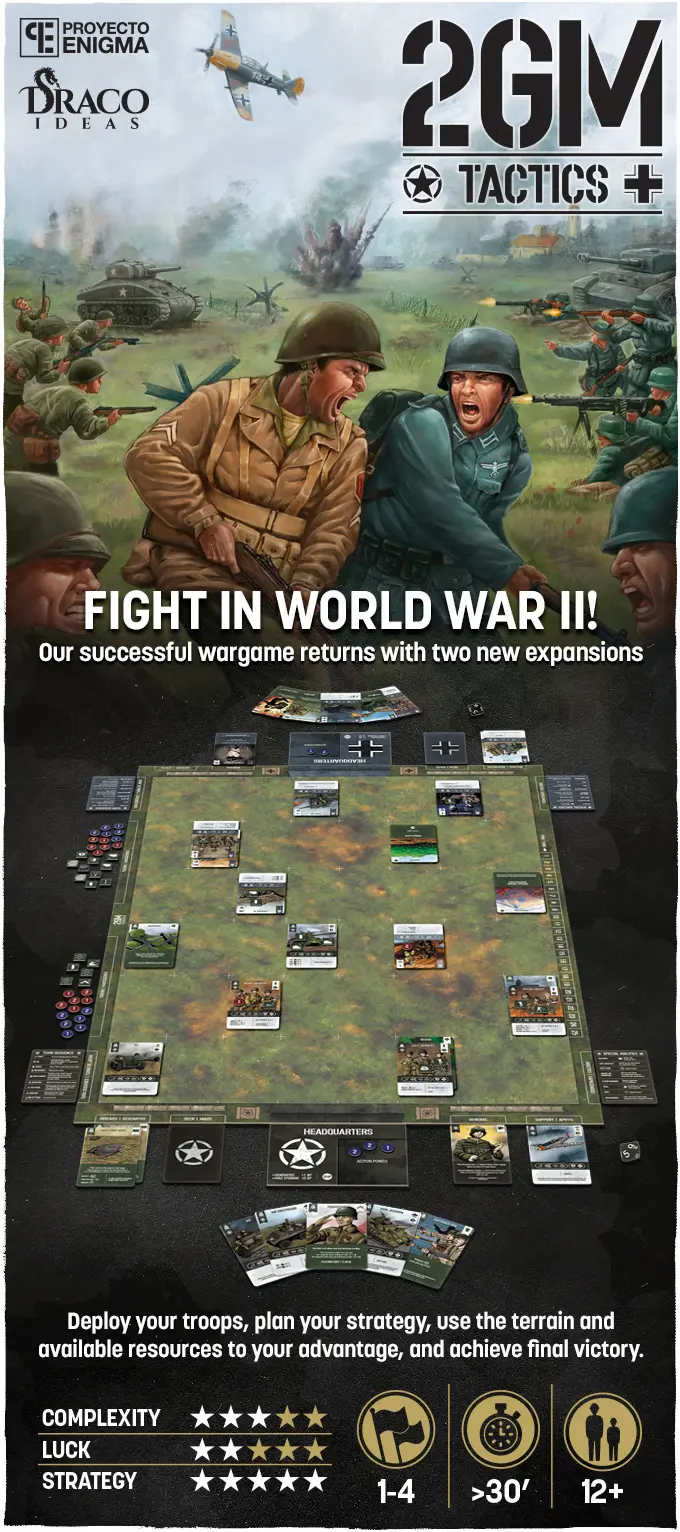
Já ando a olhar para este jogo de tabuleiro há algum tempo. Foi criado ali no país ao lado e novamente o tema é interessante. Não sou grande fã do design do jogo, mas pelo que estive a ler acho que não é por esse motivo que não iria adquirir. A campanha ainda decorrer com suporte a duas expansões: 2GM Tactics Deluxe + 2 Expansions (France e Total War). O jogo base, 2GM Tactics Deluxe tem um custo aproximado de 51 euros mais portes, mas nesta campanha anda por perto de 79 euros + portes e vat (talvez a rondar os 100 euros). Estas não são as primeiras expansões do jogo, existem outras como é o caso de UK, ITALY e GERMAN REINF.
Não comprei porque neste caso só me interessava o jogo base e está um pouco caro para aquilo que tenho nesta altura disponibilidade.
+infos(campanha): LINK
+infos(oficial): https://dracoideas.com/
Okinawa: The Last Battle of World War II, um jogo WW2 de tabuleiro
Esteve em campanha este jogo Okinawa: The Last Battle of World War II, um jogo de cartas, solitário e com um custo aproximado de +-29 euros já com portes.
Apesar do tema ser interessante, de não ter encontrado outro jogo com este tema/cenário,, achei um pouco caro e já tenho aí outros em vista para este 2024 do Mike Lambo (dois livros).
Mas fica aqui registada esta referência que pode ser que a encontre mais tarde à venda ou em segunda mão!!
+infos(campanha): LINK
RNJam’24 – GameMaker Edition
RNJam’24 – Gamemaker Edition
”
O NCGM tem o prazer de anunciar uma nova edição da RNJam, desta vez com o apoio da Opera e em colaboração com a Game Dev Lisbon, dias 21 a 23 de Junho de 2024 na FEUP.
Uma Game Jam não é só um evento onde podes te desafiar a desenvolver um jogo em 48h, mas também uma oportunidade única de te inserires numa comunidade de mentes criativas!
Nesta game jam especial, terás de criar o teu jogo na engine Gamemaker com o tema de aleatoriedade e um segundo tema relevado no dia do evento. Inscreve-te com uma equipa de até 5 membros ou sozinho e nós trataremos de completar a equipa.
Para além da Game Jam, teremos um momento de convívio organizado pela Game Dev Lisbon e Gamemaker: GameMaker Portugal Meetup – BRUNCH EDITION (LINK) que não podem perder! (+info no formulário de inscrição)
Inscrições através do LINK () até dia 19/06. Mais informações serão divulgadas em breve. Estejam atentos às nossas redes sociais e não percam tempo, inscrevam-se já!
“
a empresa Synty POLYGON
A empresa Synty, com os seus clássicos assets com o carimbo POLYGON, está com uma promoção em todos eles durante os próximos 7 dias.
Do que eu gosto e tenho seguido os preços estão bons, nomeadamente:
POLYGON – War Pack, 34,88 euros – LINK
POLYGON – War Map – WWI, 29,05 euros – LINK
POLYGON MINI – City Pack, 23,24 euros – LINK
POLYGON MINI – Fantasy Pack , 23,24 euros – LINK
Simple Racer – Cartoon Assets, 34.87 euros – LINK
Simple Roadwork – Cartoon city, 11,62 euros – LINK
Simple Trains – Cartoon Assets, 23.24 euros – LINK
são alguns dos exemplos que estão em promoção!!
referências do tema “Games for Change”
Canal de you2be: comunidade/conferência “Games for Change” – LINK
acerca de probabilidades
referências acerca de probabilidades em jogos, com exemplos de jogos de tabuleiro..
Probability Examples and Solutions
Novos Talentos FNAC 2024
Este ano os vencedores dos Novos Talentos FNAC 2024, na categoria de videojogos foram:
Vencedor – Bruno Kuipers, “WhileAwayGame”
Menção honrosa – Solange Margarido, Daniel Margarido, Guilherme Silva, Beatriz Araújo (“Codename: GOD”)
Menção honrosa – Guilherme Gama e Bruno Mascarenhas (“Beyond The Board”)
“WhileAwayGame”
“Codename: GOD”
“Beyond The Board”
Este anos o júri foi composto por:
Ricardo Fontes, João A. de Matos, André Santos e Miguel Dias
+infos(oficial): LINK
Humble Software Bundle (campanha)
Uma campanha com vários ficheiros de ambientes gráficos, personagens, para o Unreal e alguns (poucos) para o Unity, “Epic Environments Mega Bunde Unreal engine & Unity Bunde Create your fantasy world“ em que:
“Bring the fantasy world of your dreams to life in your Unity or Unreal Engine game project with this massive bundle of assets! From bustling medieval urbanscapes to ancient temple environments teeming with mystery and majesty, you’ll get tons of modular assets with which to craft play spaces that’ll enchant and transport your players. Also included are a host of characters and props to help make your environments feel convincing and lived-in”.
Da lista faz parte:
“Modular Medieval Environment
Ancient Temple Environment
Mountain Grassland Environment 2×2 km
Medieval Street Pack
Fantasy Giant’s – Modular Male with Randomization
Northern Island Pack 4×4 km
Forest Environment
Lake Houses Pack
Medieval Castle Environment
Medieval Tents & Camping Props Pack
Medieval Village Houses Pack
Medieval Village Megapack with Interiors
Medieval Windmill with interiors
Procedural Oak Forest
Modular Ancient Temple Environment – UNITY
Medieval Village Megapack with Interiors – HDRP – UNITY
Medieval Street Environment – UNITY
Modular Sorcerer – Male Humans – Fantasy Collection
Mercenary – Medieval Female Set
Mercenary – Male Humans – Fantasy Collection
Undead Knight 01 – Draugr Undead Zombie Monster Set
Medieval Village Props Package
Modular Middle Eastern Village Environment
Medieval Village Megapack with Interiors – UNITY
Old Village Houses Pack
Ancient Cave Ruins
Corpse Bandit – Draugr Undead Zombie Monster Set”
+infos(oficial): LINK
Uma campanha com vários ficheiros de áudio que podem ser usados de forma gratuita, “Epic Royalty-free Musica Collection vol.2“ em que:
“Looking for the perfect soundtrack to accompany your next project? Composer Joel Steudler invites you on a sonic journey with this colossal collection of royalty-free music from his intensive catalog! From entrancing synthwave to bombastic tunes perfect to make an impact in your trailer, this collection is packed with tracks suitable for films, games, or whatever you’re working on!”.
Synthwave
lofi Vapor
Sci-Fi Cyberpunk
Sci-Fi Orchestronica
Guitar Energy
Neoclassical Strings
Piano Moods
Retro Games
Trailer Power Vol 2
Trailer Power Vol 1
Hollywood Action
Devious Dramedy
lofi Chill
Medieval
World Traveller
Cinematic Drama
Fantasy Atmosphere
Horror Atmosphere
Powerful Percussion
Sci-Fi Atmosphere
”
+infos(oficial): LINK
Uma campanha sobre a documentação de suporte para o desenvolvimento de videojogos, “Royalty-free 001 Game Creator Stem Bundle“ em que:
“Dream of creating a game but don’t know where to start? 001 Game Creator is here to help you bring your ideas to life! This powerful, versatile, and easy to use game engine employs graphically assisted scripting to get your concepts in motion quickly without any prior coding knowledge. Get access to the engine, along with full-featured expansion kits for a variety of game genres that’ll give you a valuable head start on your projects! You’ll also get a wealth of tutorials to teach you the ropes, plus a collection of handy worksheets to help get your designs and concepts in shipshape.”.
e da lista surgem:
001 Basics E-Book + E-Learning Home Assignments
001 Resource E-Book + E-Learning Home Assignments
001 Game Creator – Point & Click Adventure
001 Game Creator – Visual Novel
001 Game Creator – Step Dungeon Maze Kit
001 Game Creator
SoftWeir Game Design Documentation Builder
SoftWeir Project Management Documentation
SoftWeir World Design Worksheet
SoftWeir Map & Dungeon Design Worksheet
SoftWeir User-Interface Design Worksheet
SoftWeir Character & Animation Design Worksheet
SoftWeir Story & Storyboard Design Worksheet
SoftWeir Script & Logic Design Worksheet
SoftWeir Item Design Worksheet
SoftWeir Weapon & Armour Design Worksheet
”
+infos(oficial): LINK
